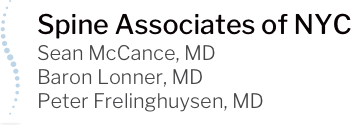A posterior lumbar interbody infusion (PLIF) is a surgical procedure regularly performed by the NYC board certified spinal surgeon, Dr. Sean McCance. PLIF is performed by the spinal surgeon to stabilize the lumbar spine: permanently stop the movement of two or more adjacent vertebrae. The main reasons for performing this spinal surgery are due to painful conditions such as spondylolisthesis (slipped disk), discogenic mechanical back pain, decompression of compressed nerves (spinal neurogenic claudication), degenerative disease of the spinal column, and degenerative scoliosis. In some instances, minimally invasive PLIF can be performed – which essentially entails smaller incisions. With posterior lumbar interbody fusion surgeries medical implants are usually employed (such as screws, rods, and cages) to hold the spine still while the bone graft becomes solid.
“I happen to work in the healthcare field and Dr. McCance is the best surgeon I have ever met. I’ve had 2 surgeries under his care and have recommend several family members and friends to him. Thanks to him I finally have my life back. Manhattan is full of well known surgeons and hospitals but none of them can compare to the care and professionalism of Dr. McCance and his staff. I can not recommend him highly enough”. ~ RateMDs
PLIF is a long-established surgical procedure for treating various degenerative disorders of the lumbar spine. The NYC spine surgeon, Dr. Sean McCance performs PLIF on patients with serious chronic painful back pain problems which tend to arise from an unstable disc or discs, or on patients suffering from spinal deformity or slippage of the bones of the spine/spondylolisthesis. Ultimately this procedure entails a bone graft to promote specific vertebrae to grow or fuse together into a solid and stable construct.
Reasons Why PLIF Surgery Is Performed
- Grade 1 – 4 spondylolisthesis
- Instability
- Scoliosis
- Re-do of a failed posterior fusion surgery or failed laminectomy
- Severe discogenic pain
- Recurrent disc prolapse with severe low back pain
- Symptomatic 1, 2, or 3 level disc degeneration and facet joint arthropathy
- Bilateral foraminal stenoses
Traditional PLIF or TLIF Technique
- The spine surgeon makes an incision on your back over the affected vertebrae.
- Lamina and facet joints may be shaved to allow more space for the nerve roots.
- Nerve roots are moved away to remove the disc or bone spur that is compressing the nerve.
- A cage and bone graft are inserted between the vertebrae.
- Screws and rods are utilized to stabilize the spine.
- Soft tissues are re-approximated and the incision is closed.
- Lumbar stenosis
Our best in class, Upper East Side, NYC back & neck pain diagnosis & surgery practice, Spine Associates, is honored to provide you with highly personalized and comprehensive care. Our philosophy of direct management of your case by an expert spine surgeon has made us one of the most trusted and respected spine surgery practices on the Upper East Side in NYC and the world. Feel free to contact the back & neck pain diagnosis and spine surgery specialist today to discuss posterior lumbar interbody infusion (PLIF) and start yourself on the road to recovery.
Dr. Sean McCance
1155 Park Avenue, Suite E
New York, NY 10128
(212) 360-6500









